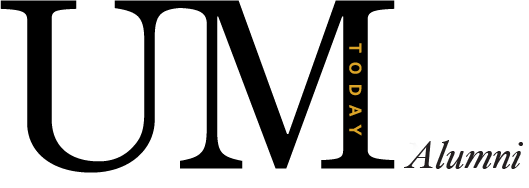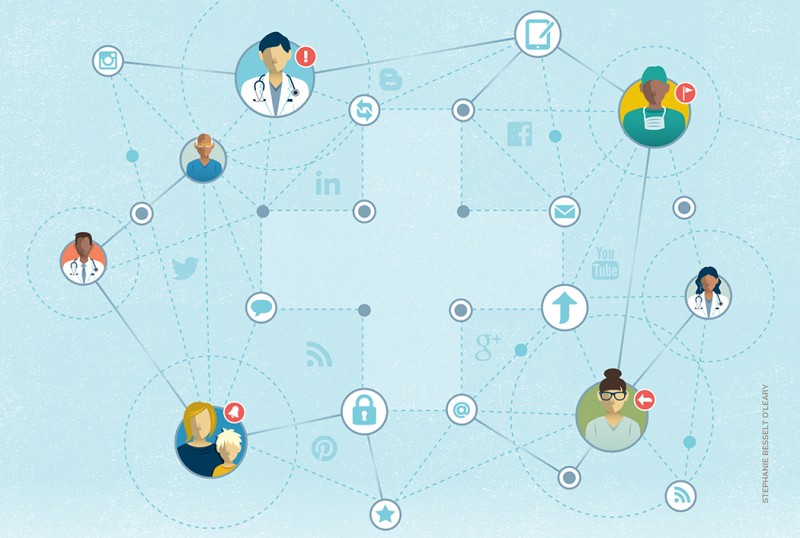
Illustration by Stephanie Besselt O'Leary.
The new social medi(a)cine
To resident otolaryngologist Dr. Ali Esmail [BSc/06, MD/10], it doesn’t make sense: rather than make his job easier, the hospital administrative software he uses to track patients needlessly consumes both time and energy. For a young doctor who is as adept at using social media as he is at performing a tonsillectomy, that seems absurd.
“Part of that frustration comes about because, as a younger generation coming in, we know there’s much better software out there doing pretty much anything else,” says Esmail, the cofounder of Winnipeg-based Koronis Health and a self-described health IT disruptor.
Enter the physician-as-entrepreneur
That’s why Esmail developed Medlinx, a social media communication platform for hospitals and clinics with a design and workflow inspired by Twitter, Facebook and Google Plus. Medlinx isn’t meant to replace the current electronic records being used, but rather provide an easy way of keeping everyone involved in a patient’s care up-to-date with what’s going on. 
When a patient is admitted, a Medlinx ‘page’ is created to track her. Health care professionals can then post comments, files, pictures or instructions from their smartphones to the page—and it’s all patient-privacy compliant.
“What I originally noticed is that people are already doing this in hospitals, but they’re using e-mail, WhatsApp or even paper notes or Excel spreadsheets to do this,” says Esmail. “We basically took all those things, said ‘What are they trying to get across using these methods?’ and then put it on one platform so that everyone can see what’s going on at that same time.”
Medlinx also offers a separate app for patients, who can then communicate with their doctors, something Esmail feels will encourage the former to take greater responsibility for their health.
College of Medicine assistant professor of general surgery Ashley Vergis has tried the software and says it’s easy to use because of the intuitive format. He thinks Medlinx could help improve communication amongst doctors, nurses and other health-care staff.
“I think we’re very conscious of communication errors and we try to avoid them as much as possible,” says Vergis. “But this is potentially the next step for really being able to tighten things up and to ensure we don’t have gaps in communication.”
While doctors may perform critically important work keeping us healthy and alive, they’re not usually known as trailblazers when it comes to using social media. A report conducted in 2014 by marketing company MedData Group found that 44 per cent of more than 250 U.S. physicians surveyed did not use social media
professionally. A majority said they were concerned about privacy issues and that they didn’t have time.
Nevertheless, Esmail is one of a growing number of physicians harnessing the power of social media to improve health care. Some are using websites like LinkedIn and The Rounds, an online community for physicians; others are employing head-mounted displays like Google Glass to stream medical procedures to teach students.
Enhancing the patient-physician relationship
Advances and acceptance of this digital technology mean many of today’s gadgets may become important tools for our health tomorrow.
“Now, medical information and even measuring health parameters are accessible to anyone,” says Bertalan Meskó, a medical futurist and author of The Guide to the Future of Medicine. “I measure my own sleep quality, I measure my physical activity. I can do an EKG at home, even an EEG right now.”
Wireless wearable devices like the Fitbit smart watch, which tracks activity levels and sleep patterns, may one day collect extended periods of health data and relay them directly to our physicians. We’ll no longer need our blood pressure taken or our heart listened to in a doctor’s office.
“In a few years, the patient will probably come to [their physician’s] office with their history and even diagnosis already written down,” says Ali Jalali, the University of Ottawa’s interim head of anatomy and a special advisor on social media for the Royal College of Physicians and Surgeons of Canada. “At that point, a patient will probably be able to do a blood test from one drop of blood analyzed on their phone.”
Others are dreaming even bigger. At a trade show last October in Japan, electronics maker Sharp showed off a prototype armchair capable of monitoring our health. The seat can measure health parameters like heart rate and body mass index before storing the information on ‘the cloud’ for a doctor to access. It includes a monitor so patients can consult directly with a physician from a distance.
“The most important change in medicine in the coming years will be the destruction of the ivory tower,” adds Meskó, a geneticist by training who is also the managing director of Webicina, a website that curates online medical resources for doctors and patients. “By deconstructing the ivory tower, you’ll see physicians who are stepping down from the tower and patients stepping up to have health management through an equal partnership.”
Social media spawns ‘meducation’
For doctors living in the present, however, social media remains a tool with big potential, especially in medical education. U of M department of pediatrics and child health associate professor Ming-Ka Chan opened her Twitter account (@MKChan_RCPSC) two years ago and uses it in part to follow news and trends from institutions like the Royal College of Physicians and Surgeons of Canada and the World Health Organization.
“I follow different topics in medical education and health in general that may be impacting practice locally, nationally and internationally—from flu vaccines to leadership development in medical education to Ebola,” says Chan, who is also responsible for faculty development.
Dr. Joseph Bednarczyk [BSc/03, MD/08], a U of M emergency physician and fellow in critical care medicine, says he finds people who are the most up-to-date in their fields and evidenced-based in their practice are all deeply involved with online resources.
“The people who are staying most current are using online resources, and this is evident on a day-to-day basis,” he says. Bednarczyk first became interested in online educational resources and social media while training to become an emergency physician.
“I became a bit frustrated with textbooks and peer-reviewed research when I was training,” recalls Bednarczyk. “I found that a lot of the stuff I read in the resources that were being recommended to me was out-of-date.”
He also found it was difficult keeping up with the volume of emergency care studies being added to Medline, the gold standard in biomedical bibliographic databases. Several thousand new articles are added to Medline every week.
Bednarczyk began hunting online for ways to keep up with cutting-edge studies on emergency care, including his interest in using heart and lung machines to keep critically ill patients alive, known as extracorporeal membrane oxygenation or ecmo for short. He started using information aggregators like Feedly to track these subjects on a daily basis, reading the latest studies before work or while getting coffee at Starbucks. He says his ability to stay hyper-current helped him extend the life of a critically ill patient last summer.
“We basically had no options left and I suggested perhaps flipping the patient prone on his stomach,” recalls Bednarczyk. Several of Bednarczyk’s colleagues had yet to read the study that supported this suggestion — after all, it had just been published that same day. A scholarly debate ended with the team agreeing to turn over the patient.
“We tried that and it changed the clinical care of the patient in that scenario,” says Bednarczyk.
Along with emergency medicine blogs, Bednarczyk says Twitter has helped him strike up collaborations with other physicians studying ecmo. He’s found that in contrast to colleagues down the hall, experts around the world are sometimes easier to reach through a tweet.
“It used to be these guys, you’d see them at a conference once a year, you’d sit in a lecture amidst a thousand other participants and maybe three or four people got to ask questions at the end of the talk,” says Bednarczyk. “Now with these resources, if I see a clinical case that’s very relevant to, for example, their research area, I might send them an e-mail or tweet something to them and usually I get an answer back within 15 or 20 minutes. It’s pretty incredible.”
Bednarczyk also follows EMCrit, one of a growing number of social media like lifeinthefastlane.com that promotes free, open-access ‘meducation’ — what’s known as FOAM. There’s now even an annual FOAM meeting, the Social Media and Critical Care Conference.
EMCrit is an emergency medicine podcast and blog published every two weeks by the director of Stony Brook University Hospital’s resuscitation and critical care unit in New York. Dr. Scott Weingart started EMCrit in 2008 and says it’s one of the most popular medical podcasts in the world.
“When I look at the concept of this generation, people want a group to talk to,” says Weingart. “You get that as an academic doctor because you’re teaching a group of residents, but I get it on such a larger scale and I get so many people giving their opinions and thoughts and interactions that it’s just insane how good that makes you feel.”
Weingart believes the FOAM movement is democratizing a system in which traditional journal editors and textbook publishers have snagged a monopoly on disseminating information. He says they hold too much power because the careers of academic doctors depend on their ability to publish high-impact papers that will change the practice of medicine.
From journal to blog: a changing of the guard
Traditionally, those physicians have submitted their research to publications like The New England Journal of Medicine, which then peer-review the research before deciding on whether it gets published. These journals usually require subscriptions which in part, their publishers argue, help pay for the peer-review process.
“That was your pathway to reaching an audience and that was your pathway to academic promotion,” says Weingart.
Now, however, a growing number of online medical journals allow their articles to be read for free while the authors pay a publishing fee. And while established so-called ‘open access’ journals are peer-reviewed, some more fly-by-night publications are not.
This, of course, has led to debate in the medical community. Who decides on what is—and isn’t—legitimate, trustworthy and accurate in social media, be it journal, tweet or blog?
“One of the biggest controversies is when you have a blog and you have one individual publishing content viewed by many, many people—in particular learners or perhaps more inexperienced clinicians or clinicians who practice in isolated environments where they don’t have a good pulse on what the standard of care is in a particular area,” says Bednarczyk. “There is concern about how influential someone can be in a medical blog post when they’re telling you how to take care of patients.”
Some organizations, like the international non-profit Health On the Net Foundation, offer accreditation of medical websites based on quality and transparency standards.
Weingart also contends that posts on medical blogs and podcasts that are followed by thousands of doctors are quickly dissected and corrected if they’re wrong.
“My show is downloaded 250,000 times a month,” says Weingart. “So I have 250,000 people doing that post-publication review. I have no fear—no fear at all—that if I make a mistake, it will be recognized.”
Better connecting researchers with subjects Social media isn’t just changing the way doctors learn; it’s also revolutionizing the way they plan and conduct research.
Two years ago, U of M pediatric surgeon and Manitoba Institute of Child Health scientist Richard Keijzer met Liz Crawford. Crawford runs a blog and Facebook page about her six-year-old son Malachi’s struggle with a rare intestinal disorder known as Hirschsprung’s disease; she was searching for accurate medical information for her hundreds of social media followers.
Keijzer and his team began providing Crawford with information on the illness. Eventually, they were able to
communicate directly with parents and Hirschsprung’s patients who helped them prioritize the information needs for this patient group. The goal is to educate them on these information gaps — things like the appropriate diet for Hirschsprung’s patients and whether new medications and treatments are effective.
The websites have been a boon for Keijzer’s research on Hirschsprung’s, considering the disease affects one in roughly 5,000 children.
“We started to engage this community and one of the things I learned was it’s really responsive and the potential reach is just amazing,” says Keijzer, who is also Thorlakson Chair in Surgical Research, and research director for the College of Medicine’s department of surgery at the U of M.
In a pilot experiment, Keijzer studied how social media could help patients and caregivers link up with others around the world suffering from the same illness. Keijzer had Crawford post links on her websites to a research survey that included a question on toilet training and Hirschsprung’s children. Within hours, Keijzer had answers from 30 to 40 parents or patients from around the world.
“For a rare disease like this, it would normally take months to get that organized,” says Keijzer.
The study was published in December in The Journal of Medical Internet Research, the highest-ranked medical informatics open access journal. Another paper by Keijzer on the medical concerns of Hirschsprung’s patients and their caregivers will be published in 2015. Keijzer says the experience will help guide future research on the disease.
“More and more grants and research proposals that we write have a paragraph or a page where we have to explain how we’re going to engage patients and how we are going to give them the information we find with our research,” says Keijzer. “You can do this with a rare disease in a timely and efficient manner with the help of social media.”
As for Crawford, she’s amazed at how much research has taken place in two years. “It’s just astounding from what I see from the outside,” she says. “Knowing how medicine works and how long things take to get done, I’m absolutely mind-blown by it.”
Google and Twitter join vaccines in the fight against infectious disease
Some websites like HealthMap are even tracking outbreaks of disease and illness by monitoring online sources. Although crunching the big data of social media isn’t always the information panacea it may seem to be — a similar website, Google Flu Trends, was criticized last year for frequently over-estimating the number of seasonal flu cases — many see promise in it.
Last January, researchers at the University of California, Los Angeles, published a study showing how real-time social media networks could help health officials monitor and possibly prevent behaviours that put people at risk for contracting HIV. The researchers analyzed tweets with keywords suggesting risky behaviour associated with HIV transmission. They then mapped out the locations of those tweets before linking them to data on the geographical distribution of HIV cases. According to the UCLA, the researchers ended up finding a “significant relationship between (tweets) indicating risky behaviour and counties where the highest numbers of HIV cases were reported.
Tapping the well of social media’s potential
It’s a creative approach to using social media — the sort of creativity that was encouraged at the first ever Hacking Health event held last November in Winnipeg. Hacking Health events bring together the likes of developers, graphic designers and front-line clinicians to collaborate on new products and prototypes for the health-care industry. The idea is to give inventors a head start by quickly prototyping interactive digital media ideas that can be tested over the three-day health hackathon. In this way, physicians and researchers can avoid becoming prematurely bogged down with complications like privacy laws or industry regulations.
“Let’s strip away all those barriers for a moment and let’s just talk about how we can create the best client experience — privacy concerns be damned kind of thing,” says New Media Manitoba executive director Kevin Hnatiuk [BA/97], who co-chaired the event. “It’s within this whole stripping away of the barriers that I believe the greatest innovation occurs.”
In 2013, a Hacking Health event held in Toronto led to the successful development of an app that helps young, pregnant, homeless women manage prenatal care for their babies. Still, Hnatiuk believes the goal of these events isn’t just the development of the next big digital health-care product.
“Hackathons aren’t necessarily about creating something that’s commercially viable,” he says. “It’s creating something that improves the human condition in some way. It’s all about planting seeds, right?”
For Esmail, those seeds are already beginning to sprout. Once Medlinx passes its security audits by the Winnipeg Regional Health Authority, it will be tested in St. Boniface Hospital’s surgery division. Esmail’s hoping it will be available to health-care facilities across Canada and the United States this January.
“Social media is such a phenomenon because it allows people to connect,” says Esmail. “I can’t think of a place where this would be more important than in a hospital where the stakes are so high. Social media repurposed for health care in the form of clinical social networks is going to transform the way care is delivered over the next five years.”
This article originally appeared in the Winter 2015 edition of On Manitoba, the U of M’s alumni magazine.








